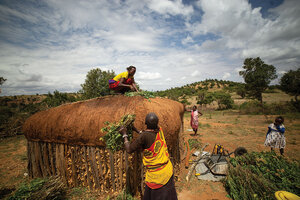In Pictures: Kenya’s forgotten Yaaku take back their language

Community members build a manyatta, a Maasai term for a dwelling, for Juliana Lorisho near the construction site for her language learning center.
KANG-CHUN CHENG
Mukogodo Forest, Kenya
Grabbing the diiche, a prickly cactus bulb, away from my novice hands, Juliana Lorisho expertly uses a leafy branch to remove the spines before splitting the fruit open with her fingers. Unexpectedly bright juice splurts out, staining white fabric fuchsia. It tastes acerbic and fresh. The diiche is just one of the many edible fruits found within the Mukogodo, Kenya’s sole Indigenous-owned forest.
“It’s paradise, isn’t it,” Ms. Lorisho says, surveying the path lined with goldenrod-colored neeyna flowers.
This place is integral to Ms. Lorisho’s cultural identity. So are the words she uses to describe it. These are remnants of the Yaaku community, a tiny population of an estimated 4,000 in Kenya that was forced to assimilate with the Maasai ethnic group a century ago.
Why We Wrote This
In a globalizing world, many minority languages are on the cusp of collapsing. But native speakers seek their revival anyway – not out of practicality, but rather out of dignity.
Ms. Lorisho and her grandfather are the two remaining fluent speakers of Yaakunte. In a last-ditch effort to save the language of her ancestors, Ms. Lorisho left a stable accounting position in urban Nanyuki and returned to the edge of the Mukogodo Forest with a dream of founding a school.
“I have a great mission towards reviving Yaakunte because many Yaaku are interested in speaking the language,” she says.
She was still seeking funds when UNESCO declared Yaakunte extinct in August 2020. With renewed urgency, she sought an interim solution. She launched a “Revival of Yaaku Language” group on the encrypted messaging application WhatsApp.
Hovering around 33 participants, the group utilizes text and voice messages to learn new words. “It is a way for us to practice our culture and be differentiated from other communities we assimilated to,” she says.


